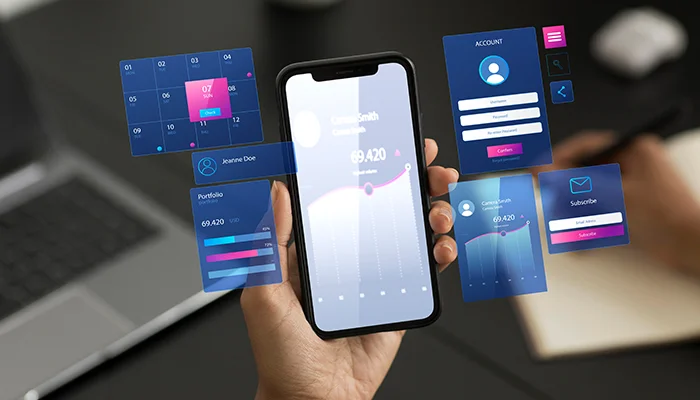How to Build a DeFi App: Costs, Features, Process, and Types

JUL, 22, 2024 15:00 PM
How to Build a DeFi App: Costs, Features, Process, and Types
Decentralized Finance (DeFi) has revolutionized the financial landscape by leveraging blockchain technology to provide financial services without intermediaries. Building a DeFi app requires a deep understanding of blockchain technology, smart contracts, and the financial ecosystem. This comprehensive guide will explore the types of DeFi apps, essential features, development process, and associated costs, providing a blueprint for creating successful DeFi applications.
Introduction to DeFi
What is DeFi?
Decentralized Finance (DeFi) refers to a system where financial products are available on a public decentralized blockchain network, making them accessible to anyone without the need for intermediaries like banks or brokers. DeFi platforms utilize smart contracts to automate financial transactions, offering services such as lending, borrowing, trading, and insurance.
Key Benefits of DeFi
- Accessibility: DeFi services are accessible to anyone with an internet connection, eliminating geographical and economic barriers.
- Transparency: Transactions and smart contracts are recorded on a public blockchain, providing transparency and reducing the risk of fraud.
- Efficiency: DeFi applications streamline financial processes, reducing costs and increasing transaction speeds.
- Security: Blockchain technology ensures the security and immutability of transactions, protecting user data and assets.
Types of DeFi Applications
1. Decentralized Exchanges (DEXs)
Decentralized exchanges allow users to trade cryptocurrencies directly with one another without the need for a central authority. Key features include:
- Peer-to-Peer Trading: Enables direct trading between users.
- Automated Market Making (AMM): uses smart contracts to create liquidity pools and facilitate trades.
- Token Swaps: This allows users to exchange one cryptocurrency for another instantly.
2. Lending and Borrowing Platforms
DeFi lending and borrowing platforms enable users to lend their assets to others or borrow assets against collateral. Key features include:
- Collateralized Loans: This requires borrowers to provide collateral to secure loans.
- Interest rates are automatically adjusted based on supply and demand.
- Flash Loans: Unsecured loans that must be repaid within a single transaction.
3. Stablecoins
Stablecoins are cryptocurrencies pegged to a stable asset, such as a fiat currency, to minimize price volatility. Key features include:
- Pegging Mechanism: Maintains the value of the stablecoin relative to the pegged asset.
- Collateralization: backed by reserves of the pegged asset or other cryptocurrencies.
- Decentralized Governance: Managed by decentralized protocols and smart contracts.
4. Yield Farming and Staking
Yield farming and staking platforms allow users to earn rewards by providing liquidity or staking their assets. Key features include:
- Liquidity Provision: Users provide liquidity to pools and earn rewards.
- Staking: Users lock their assets into a protocol to support network operations and earn rewards.
- Rewards Distribution: Automatically distributed based on user participation.
5. Insurance Protocols
DeFi insurance protocols offer coverage against various risks, such as smart contract failures and hacks. Key features include:
- Risk Assessment: Evaluates the risk and determines premiums.
- Decentralized Claims Processing: Processes claims through smart contracts.
- Coverage Pools: Funded by user contributions and managed by the protocol.
Essential Features of DeFi Apps

1. Smart Contract Integration
Smart contracts are the backbone of DeFi applications, automating financial transactions and ensuring trustless operations. Key features include:
- Automated Execution: Executes transactions automatically based on predefined conditions.
- Transparency: Code and transactions are visible on the blockchain.
- Immutability: Once deployed, smart contracts cannot be altered, ensuring security and reliability.
2. User Interface (UI) and User Experience (UX)
A user-friendly and intuitive UI/UX is crucial for DeFi apps to attract and retain users. Key features include:
- Responsive Design: Ensures a seamless experience across devices.
- Easy Navigation: Simplifies access to various features and functions.
- Clear Instructions: Provides guidance and explanations to help users understand complex financial concepts.
3. Security and Compliance
Ensuring the security and compliance of DeFi apps is paramount to protecting user assets and data. Key features include:
- Audited Smart Contracts: Regular audits by third-party security firms to identify and fix vulnerabilities.
- Data encryption protects user data and transactions from unauthorized access.
- Regulatory Compliance: Adheres to relevant regulations and standards to ensure legal operations.
4. Interoperability
Interoperability allows DeFi apps to interact with other blockchain networks and protocols, enhancing functionality and the user experience. Key features include:
- Cross-Chain Compatibility: Supports transactions and interactions across different blockchain networks.
- Integration with External Services: Connects with external services, such as oracles, to access off-chain data.
- Token Standards: Adheres to common token standards (e.g., ERC-20, ERC-721) for seamless integration.
5. Decentralized Governance
Decentralized governance allows the community to participate in decision-making processes, ensuring transparency and inclusivity. Key features include:
- Voting Mechanisms: Enables users to vote on protocol changes and proposals.
- Governance tokens represent voting power and incentivize participation.
- Proposal System: Allows users to submit and discuss proposals for protocol improvements.
The Process of Building a DeFi App
1. Ideation and conceptualization
The first step in building a DeFi app is to define the concept and objectives. This involves:
- Identifying the Problem: Understanding the financial problem or inefficiency that the app will address.
- Defining the Solution: conceptualizing the app’s features and functionalities that will solve the problem.
- Market Research: Analyzing market trends, user needs, and competitor offerings to validate the idea.
2. Choosing the Blockchain Platform
Selecting the right blockchain platform is crucial for the success of the DeFi app. Key considerations include:
- Scalability: The platform should handle a high volume of transactions efficiently.
- Security: The platform should offer robust security features to protect user assets.
- Ecosystem: A vibrant ecosystem with developer tools, libraries, and community support is beneficial.
3. Designing the architecture
Designing the architecture involves defining the technical structure and components of the DeFi app. This includes:
- Smart Contracts: Designing the smart contracts that will automate the app’s functionalities.
- Backend Infrastructure: Setting up the backend systems for data storage, user authentication, and transaction processing.
- Frontend Development: Creating the user interface and user experience design.
4. Development
The development phase involves coding and implementing the DeFi app. Key activities include:
- Smart Contract Development: Writing and deploying smart contracts on the chosen blockchain platform.
- Backend Development: Setting up the server, database, and API integrations.
- Frontend Development: Developing the user interface and integrating it with the backend and smart contracts.
5. Testing and auditing
Thorough testing and auditing are essential to ensuring the security and functionality of the DeFi app. Key activities include:
- Unit Testing: Testing individual components and functions.
- Integration Testing: Ensuring all components work together seamlessly.
- Security Audits: Conducting third-party audits of the smart contracts and overall system to identify vulnerabilities.
6. Deployment
Deploying the DeFi app involves making it available to users on the blockchain. Key steps include:
- Smart Contract Deployment: Deploying the smart contracts to the mainnet.
- Frontend and Backend Deployment: Deploying the frontend and backend systems to production servers.
- Launch and Promotion: Launching the app and promoting it to attract users.
7. Maintenance and Updates
Ongoing maintenance and updates are necessary to keep the DeFi app secure and functional. Key activities include:
- Monitoring: Continuously monitor the app for performance and security issues.
- Bug Fixes and Enhancements: Addressing bugs and implementing new features based on user feedback.
- Regular Audits: Conducting periodic security audits to ensure the app remains secure.
Costs of Building a DeFi App
1. Factors Influencing the Cost
The cost of building a DeFi app can vary widely depending on several factors, including:
- Complexity of the App: More complex apps with advanced features will be more expensive to develop.
- Blockchain Platform: The choice of blockchain platform can impact development costs, with some platforms being more cost-effective than others.
- Development Team: The size and expertise of the development team will influence the cost.
- Testing and Auditing: Thorough testing and security audits can add to the cost but are essential for ensuring quality and security.
- Maintenance and Support: Ongoing maintenance and support can also contribute to the overall cost.
2. Estimated Costs
While it's challenging to provide a precise cost estimate without specific requirements, here are some rough estimates for different types of DeFi apps:
- Decentralized Exchanges (DEXs): $300,000 to $1 million, depending on the complexity and features.
- Lending and Borrowing Platforms: $200,000 to $800,000, depending on the scope and functionality.
- Stablecoins: $150,000 to $500,000, depending on the pegging mechanism and collateralization.
- Yield Farming and Staking Platforms: $100,000 to $500,000, depending on the reward mechanisms and integration.
- Insurance Protocols: $200,000 to $700,000, depending on the risk assessment and claims processing features.
3. Cost-Saving Strategies
To manage costs effectively, consider the following cost-saving strategies:
- Agile Development: Use agile development methodologies to deliver value incrementally and manage changes efficiently.
- Outsourcing: Consider outsourcing certain development tasks to specialized vendors or offshore teams.
- Reuse of Existing Components: Leverage existing smart contracts and open-source libraries to reduce development time and cost.
- Cloud Services: Utilize cloud services for backend infrastructure to minimize setup and maintenance costs.
Conclusion
Building a DeFi app is a complex and multifaceted process that requires a deep understanding of blockchain technology, smart contracts, and the financial ecosystem. By understanding the different types of DeFi apps, their essential features, development processes, and associated costs, you can create innovative and high-quality DeFi applications that offer decentralized financial services to users.
At PerfectionGeeks Technologies, we specialize in developing cutting-edge DeFi applications. Our team of experts can help you navigate the complexities of DeFi development, from initial concept to deployment and maintenance. Contact us today to learn more about our services and how we can help you build exceptional DeFi applications.
FAQs on Building a DeFi App
- What are the key features to include in a DeFi app?
A successful DeFi app should include several key features, such as smart contract integration for automated and trustless transactions, a user-friendly interface for easy navigation, robust security measures to protect user data and assets, interoperability with other blockchain networks and protocols, and decentralized governance to involve the community in decision-making processes.
- How much does it cost to build a DeFi app?
The cost of building a DeFi app can vary widely depending on the app's complexity, the chosen blockchain platform, the size and expertise of the development team, and the extent of testing and security audits. Generally, costs can range from $100,000 for simpler yield farming platforms to over $1 million for complex decentralized exchanges (DEXs) and autonomous financial platforms.
- What is the typical process for developing a DeFi app?
Developing a DeFi app typically involves several key steps: ideation and conceptualization to define the app's objectives and features; choosing the appropriate blockchain platform; designing the system architecture; developing the smart contracts and frontend/backend systems; thorough testing and security audits; deploying the app on the blockchain; and ongoing maintenance and updates to ensure security and functionality.
Strategy
Design
Blockchain Solution
Development
Launching
Testing
Maintenance
Contact US!
India

Plot 378-379, Udyog Vihar Phase 4 Rd, near nokia building, Electronic City, Phase IV, Sector 19, Gurugram, Haryana 122015
Copyright © 2025 PerfectionGeeks Technologies | All Rights Reserved | Policy
Strategy
Design
Blockchain Solution
Development
Contact US!
India 
Plot 378-379, Udyog Vihar Phase 4 Rd, near nokia building, Electronic City, Phase IV, Sector 19, Gurugram, Haryana 122015
USA 
1968 S. Coast Hwy, Laguna Beach, CA 92651, United States
Copyright © 2025 PerfectionGeeks Technologies | All Rights Reserved | Policy






